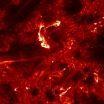(Press-News.org) Why is the Sun's million-degree corona, or outermost atmosphere, so much hotter than the Sun's surface? This question has baffled astronomers for decades. Today, a team led by Paola Testa of the Harvard-Smithsonian Center for Astrophysics (CfA) is presenting new clues to the mystery of coronal heating using observations from the recently launched Interface Region Imaging Spectrograph (IRIS). The team finds that miniature solar flares called "nanoflares" - and the speedy electrons they produce - might partly be the source of that heat, at least in some of the hottest parts of the Sun's corona.
A solar flare occurs when a patch of the Sun brightens dramatically at all wavelengths of light. During flares, solar plasma is heated to tens of millions of degrees in a matter of seconds or minutes. Flares also can accelerate electrons (and protons) from the solar plasma to a large fraction of the speed of light. These high-energy electrons can have a significant impact when they reach Earth, causing spectacular aurorae but also disrupting communications, affecting GPS signals, and damaging power grids.
Those speedy electrons also can be generated by scaled-down versions of flares called nanoflares, which are about a billion times less energetic than regular solar flares. "These nanoflares, as well as the energetic particles possibly associated with them, are difficult to study because we can't observe them directly," says Testa.
Testa and her colleagues have found that IRIS provides a new way to observe the telltale signs of nanoflares by looking at the footpoints of coronal loops. As the name suggests, coronal loops are loops of hot plasma that extend from the Sun's surface out into the corona and glow brightly in ultraviolet and X-rays.
IRIS does not observe the hottest coronal plasma in these loops, which can reach temperatures of several million degrees. Instead, it detects the ultraviolet emission from the cooler plasma (~18,000 to 180,000 degrees Fahrenheit) at their footpoints. Even if IRIS can't observe the coronal heating events directly, it reveals the traces of those events when they show up as short-lived, small-scale brightenings at the footpoints of the loops.
The team inferred the presence of high-energy electrons using IRIS high-resolution ultraviolet imaging and spectroscopic observations of those footpoint brightenings. Using computer simulations, they modeled the response of the plasma confined in loops to the energy transported by energetic electrons. The simulations revealed that energy likely was deposited by electrons traveling at about 20 percent of the speed of light.
The high spatial, temporal, and spectral resolution of IRIS was crucial to the discovery. IRIS can resolve solar features only 150 miles in size, has a temporal resolution of a few seconds, and has a spectral resolution capable of measuring plasma flows of a few miles per second.
Finding high-energy electrons that aren't associated with large flares suggests that the solar corona is, at least partly, heated by nanoflares. The new observations, combined with computer modeling, also help astronomers to understand how electrons are accelerated to such high speeds and energies - a process that plays a major role in a wide range of astrophysical phenomena from cosmic rays to supernova remnants. These findings also indicate that nanoflares are powerful, natural particle accelerators despite having energies about a billion times lower than large solar flares.
"As usual for science, this work opens up an entirely new set of questions. For example, how frequent are nanoflares? How common are energetic particles in the non-flaring corona? How different are the physical processes at work in these nanoflares compared to larger flares?" says Testa.
INFORMATION:
Researchers at the University of Connecticut have found a new way to identify protein mutations in cancer cells. The novel method is being used to develop personalized vaccines to treat patients with ovarian cancer.
"This has the potential to dramatically change how we treat cancer," says Dr. Pramod Srivastava, director of the Carole and Ray Neag Comprehensive Cancer Center at UConn Health and one of the principal investigators on the study. "This research will serve as the basis for the first ever genomics-driven personalized medicine clinical trial in immunotherapy ...
Antibiotic-resistant bacteria can share resources to cause chronic infections, Vanderbilt University investigators have discovered. Like the individual members of a gang who might be relatively harmless alone, they turn deadly when they get together with their "friends."
The findings, reported Oct. 8 in Cell Host & Microbe, shed light on a long-standing question in infectious diseases and may inform new treatment strategies, said Eric Skaar, Ph.D., MPH, Ernest W. Goodpasture Professor of Pathology, Microbiology and Immunology.
One way that Staphylococcus aureus and other ...
Using the NASA/ESA Hubble Space Telescope astronomers have made what may be the most reliable distance measurement yet of an object that existed in the Universe's formative years. The galaxy is one of the faintest, smallest and most distant galaxies ever seen and measuring its distance with this accuracy was possible due only to the incredibly detailed mapping of how giant galaxy clusters warp the space-time around them.
Astronomers often use gravitational lensing -- the magnifying power of galaxy clusters -- to find distant galaxies [1]. However, when it comes to the ...
Boulder, Colo., USA - What is the "Sixth Extinction"? How do paleontologists determine North America's future fire threats? What do trilobites look like on the inside? Did the Chicxulub impact trigger an eruption? Here, the Paleontological Society highlights some of the best science and current work in paleontology to be presented at the 126th Annual Meeting of The Geological Society of America on 19-22 October in Vancouver, BC, Canada.
SUNDAY, 18 Oct.
Geospatial Analysis of Human-Megafaunal Overlap in North America: Lead author Meaghan Emery and colleagues write that ...
Organisms ranging from bacteria to humans have circadian clocks to help them synchronize their biological activities to the time of day. A study published by Cell Press October 16th in Cell now reveals that gut microbes in mice and humans have circadian rhythms that are controlled by the biological clock of the host in which they reside. Disruption of the circadian clock in the host alters the rhythms and composition of the microbial community, leading to obesity and metabolic problems.
"These findings provide an explanation for a long-standing and mysterious observation, ...
Supplementing the diet with omega-6 polyunsaturated fatty acids has beneficial effects on heart health by lowering "bad" LDL cholesterol and raising "good" HDL cholesterol, but the underlying mechanisms involved are poorly understood. Now research based on the genetic information from over 100,000 individuals of European ancestry has uncovered a gene that affects blood cholesterol levels through the generation of a compound from omega-6 polyunsaturated fatty acids, called lipoxins. The study, publishing online October 16 in the Cell Press journal Cell Metabolism, also provides ...
Researchers have found that male and female brains respond in remarkably different ways to high-fat meals. Those differences in the brain lead to greater inflammation and increased health risks in males that indulge on fatty foods in comparison to females, a new study in mice shows. The findings reported in the Cell Press journal Cell Reports on October 16th may help to explain observed differences in obesity outcomes between women and men – premenopausal women carrying extra weight fare better than men do – and suggest that dietary advice should be made more ...
Two closely related viruses that have been introduced to northern Spain in recent years have already led to the collapse of three different species of amphibian—the common midwife toad, the common toad, and the alpine newt—in the protected area of Picos de Europa (literally "Peaks of Europe") National Park. In all, six amphibian species have suffered from severe disease and mass mortality as a result of the outbreak, and researchers who report their findings in the Cell Press journal Current Biology on October 16 say that the viruses appear to be on the move. ...
Scientists tracing the real-time impact of viruses in the wild have found that entire amphibian communities are being killed off by closely related viruses introduced to mountainous areas of northern Spain.
Researchers from UCL, Zoological Society of London (ZSL) and Queen Mary University of London (QMUL) in the UK, and the National Museum of Natural Sciences (MNCN-CSIC) in Madrid, Spain found the viruses are causing severe disease and mass deaths in many amphibian species sampled, including frogs and salamanders. The common midwife toad, common toad and alpine newt ...
A newly discovered population of immune cells in tumors is associated with less severe cancer outcomes in humans, and may have therapeutic potential, according to a new UC San Francisco study of 3,600 human tumors of 12 types, as well as mouse experiments.
The research is published online October 16, 2014 in the journal Cancer Cell.
Molecules associated with these cells, newly identified by the UCSF researchers, could be the focus of new immunotherapies that are more precisely targeted than current immunotherapies now in clinical trials, said Matthew Krummel, PhD, professor ...



